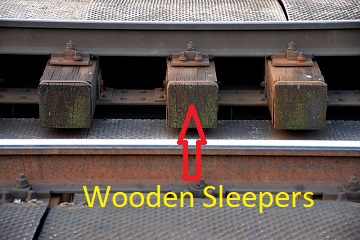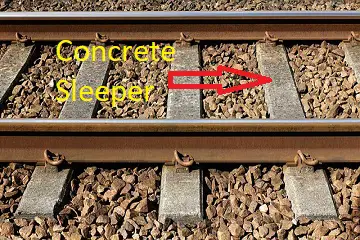In this blog post I will describe the different types of sleepers used in Railways.
First of all we will know the basics of railway sleepers.
Table of Contents
Introduction:
Railway sleepers, also known as railroad ties, are an essential component of the railway system. They serve as the foundation for the rails and provide a stable surface for trains to travel on. In this article, we will delve into the various types of railway sleepers, their history, manufacturing, and maintenance.
History:
Railway sleepers have been used since the early days of railways, and their design has evolved over time. The earliest sleepers were made of stone or wood, but as railways became more widespread, it became necessary to find more durable materials. In the mid-19th century, cast iron sleepers were introduced, but they were heavy and prone to breakage. In the late 19th century, steel sleepers were developed, which were lighter and more durable than their cast iron predecessors. Today, concrete sleepers are the most common type of railway sleeper, as they are cost-effective, durable, and easy to manufacture.
Manufacturing:
The manufacturing process for railway sleepers varies depending on the type of sleeper being produced. For wooden sleepers, the process involves cutting and shaping the wood to the required size and shape, treating it with preservatives to prevent rot and insect damage, and then allowing it to dry. Concrete sleepers are manufactured using precast concrete molds, which are filled with concrete and then allowed to set. Steel sleepers are typically manufactured by rolling steel into the required shape and then treating it with anti-corrosion coatings. Composite sleepers are made by combining materials such as plastic and concrete and then molding them into the required shape.
Types Of Sleepers
There are different types of sleepers used in railway, according to their suitability, availability, economy, and design.
Depending on the material used in the construction, types of sleepers used in railway can be classified into the following three categories:
- Wooden sleepers.
- Metal sleepers (Steel sleepers and Cast iron sleepers).
- Concrete sleepers (Reinforced concrete sleepers and Prestressed concrete sleepers).
1. Wooden Sleepers:
Sleepers made of timber are called wooden sleepers. These sleepers were broadly used as the best type of sleepers as they fulfilled all the requirements of an ideal sleeper. But these are now outdated and not used widely.
Advantages Of Wooden Sleepers:
- Timber is an easily available material.
- The initial cost of the wooden sleeper is very low.
- They need few fastenings which are also simple to design.
- Wooden sleepers are easy to handle.
- These sleepers Suitable for all types of ballast.
- They can be utilized with every section of rails and for any gauge of track.
- The extent of damage during accidents is fewer.
- Best used for track circuiting.
- Easy replacement of the track.
Disadvantages Of Wooden Sleepers:
- The life span of wooden sleepers is minimum (12 to 15 years) compared to other kinds of sleepers.
- They are likely to decay, attack white ants, wear, spike killing, cracking, splitting, rail cutting, etc.
- The lateral and longitudinal rigidity of the track is fewer as the connections between the rails and the sleepers are not much strong.
- Difficulty in keeping a gauge of the track.
- Higher maintenance cost.
- Low scrap value.

2. Metal Sleepers:
The sleepers normally made of cast iron or steel are known as metal sleepers. Due to the growing shortage of timber to be used for wooden sleepers, their high maintenance, cast, and short life, metal sleepers are now being broadly used.
Metal sleepers are two types:
(a) Steel Sleepers:
The sleepers made of steel are called steel sleepers. Steel sleepers are broadly used with excellent results.
Types of steel sleepers:
- Key type steel sleepers.
- Clip and bolt type steel sleepers.
(b) Cast Iron Sleepers:
The sleepers made of cast iron are called cast iron sleepers. These sleepers are normally used in America than in any other country in the world.
Types of cast iron sleepers:
- Pot or bowl sleeper.
- Plate sleeper.
- Box sleeper.
- CST-9 sleeper.
- Duplex sleeper.
Advantages Of Metal Sleepers:
- Long-lasting (35 to 50 years).
- Metal Sleepers are uniform in strength and durability.
- The gauge can be easily adjusted and maintained easily.
- The lateral and longitudinal stability of the track is more.
- Renewal is not regular.
- Very High scrap value.
Disadvantages Of Metal Sleepers:
- They need more fittings.
- Metal is likely to rust.
- Need more quantity of ballast.
- These sleepers are not appropriate for bridges, level crossing, etc.
- More damage during accidents.

3. Concrete Sleepers:
The sleepers made of reinforced or prestressed cement concrete are called concrete sleepers.
Types of concrete sleepers:
(a) RCC sleepers:
The concrete sleepers constructed of reinforced cement concrete are known as RCC sleepers.
RCC sleepers are the following two types:
- Mono-black sleepers.
- Two back sleepers.
(b) Prestressed Concrete Sleepers:
Concrete sleepers constructed of prestressed cement concrete are called prestressed concrete sleepers.
Advantages Of Concrete Sleepers:
- Long-lasting ( 40 to 60 years).
- Need fewer fittings.
- Adjustment of the gauge is very simple and easy.
- They stipulate strong connections between rail and sleeper.
- The lateral and longitudinal stability of the track is high.
- Track circuiting is achievable.
- More durable and not likely to decay.
- Less creep in the railway track.
- They can withstand the stresses evoked by fast-moving and heavy traffic.
- The maintenance cost is Low.
Disadvantages Of Concrete Sleepers:
- The initial cost is very high.
- Likely to break under rough handling or due to improper design.
- Renewal is a little bit challenging.
- The scrap value is zero.

Uses Of Railway Sleepers
- Railway sleepers can support and secure the rails on a railway track.
- People often use railway sleepers to create retaining walls, garden steps, and raised flower beds in a garden or landscaping project.
- Old or reclaimed railway sleepers make unique and rustic furniture pieces such as benches, tables, and shelves.
- Railway sleepers can provide a strong and durable foundation for buildings or be a part of a construction project, such as bridge abutments.
- You can use railway sleepers to create pathways or walkways in a garden or outdoor area.
- Railway sleepers can serve as sound barriers.
